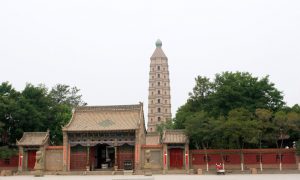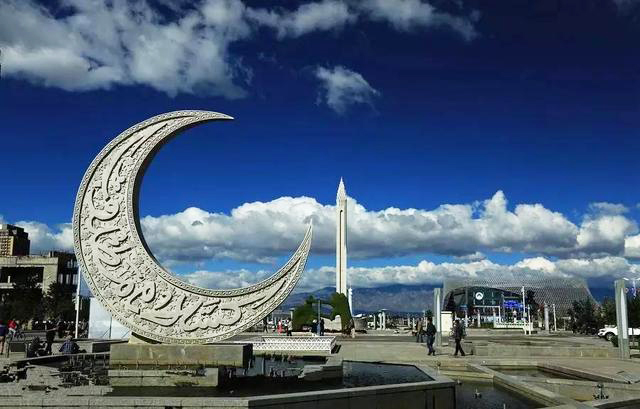Flanked by the Yellow River to the east and the Helan Mountains to the west, Yinchuan is commonly known as the “land of fish and rice”, since its auspicious location provides an abundance of fertile land that is otherwise scarce in northern China. It serves as the provincial capital of the Ningxia Hui Autonomous Region, a place dominated by the Muslim Hui ethnic minority. One of its major claims to fame is that it was potentially the place where the great Genghis Khan finally died in 1227. Although no one knows exactly where this mighty Mongolian warlord breathed his last, his death and the circumstances surrounding it offer great insight into the history of this unusual city.
During the fall of the illustrious Tang Dynasty (618-907), Ningxia and several of China’s northeastern provinces were occupied by the Tangut people. After conquering this territory, they established the Western Xia Dynasty (1038-1227) and chose Yinchuan as their imperial capital. It was during the Mongolian invasion of China, when Genghis Khan was in the process of overthrowing the Western Xia Dynasty, that he met his unfortunate end, possibly in Yinchuan but most likely somewhere in Ningxia. Talk about poor timing! His grandson, Kublai Khan, went on to complete his work and eventually seized control of China proper under the Yuan Dynasty (1271-1368).
The plains surrounding Yinchuan are intensively irrigated by systems that date back to the Han (206 BC–220 AD) and Tang dynasties. From herds led by nomads on the grasslands to farms cultivating the locally famous wolfberries, it is renowned as a region of bountiful harvests and superlative agricultural products. One third of its population is made up of the Hui ethnic minority, meaning the city is littered with spectacular mosques and restaurants serving delicious traditional Hui cuisine.
Yet it’s the city’s history that has left behind the greatest treasures of all. The Western Xia Tombs, located approximately 35 kilometres (22 mi) east of the city, are one of the last known relics of this mysterious kingdom. This magnificent tomb complex is composed of over 250 separate mausoleums, nine of which belong to Western Xia kings and about 140 contain imperial family members. Taking up a total area of over 49 square kilometres (19 sq. mi), it is one of the largest and most well-preserved imperial burial sites in China. Its architecture is a hectic mixture of traditional Han Chinese, Buddhist, and Tangut features, demonstrating how these cultures intermingled in the region.
Nowadays, only two mausoleums are open to the public: the Haowang Mausoleum and the Shuang Mausoleum. However, tourists are free to wander through the complex and admire its architecture. The nearby Western Xia Museum, Western Xia Art Museum, and Western Xia Collection of Stone Inscriptions are the ideal place to learn more about the history of the site. This fascinating place represents just one of more than 60 historic sites that can be found in Yinchuan, including mosques, pagodas, pavilions, and elaborate temples.
 Of these, the most popular are the Haibao Pagoda and the Pagoda of Chengtian Temple. The eleven-storeyed Pagoda of Chengtian Temple was originally built during the Western Xia Dynasty, but was tragically destroyed and had to be rebuilt during the Qing Dynasty (1644-1912). Towering in at a height of over 64 metres (212 ft.), it is the largest pagoda in Ningxia. A wooden staircase leads to the top of the pagoda, where windows facing in four directions offer a stunning panoramic view of the city.
Of these, the most popular are the Haibao Pagoda and the Pagoda of Chengtian Temple. The eleven-storeyed Pagoda of Chengtian Temple was originally built during the Western Xia Dynasty, but was tragically destroyed and had to be rebuilt during the Qing Dynasty (1644-1912). Towering in at a height of over 64 metres (212 ft.), it is the largest pagoda in Ningxia. A wooden staircase leads to the top of the pagoda, where windows facing in four directions offer a stunning panoramic view of the city.
That being said, if you like your history with a side of glitz and glamour, you may want to consider a visit to China West Film Studio. Located at the eastern foot of the Helan Mountains just 25 kilometres (16 mi) outside of the city, it has served as the set for over 100 films, including celebrated works like Zhang Yimou’s Red Sorghum. The studio was formerly the site of two ancient castles, built during the Ming (1368-1644) and Qing dynasties respectively.
Nowadays it is separated into three areas: Qing Dynasty Town, Ming Dynasty Town, and Yinchuan Old Street. It’s is currently open to the public and offers visitors the opportunity to experience what life was like in ancient China. If you really want to get in on the action, you can even rent a traditional costume and have your photo taken in front of the beautifully crafted sets!
For nature lovers and bird-watchers alike, Sand Lake is just 56 kilometres (35 mi) north of Yinchuan and represents a bizarre wonderland of sandy desert and shimmering lakes. It is considered one of the best places in China for bird-watching, since it is home to over one million birds from 198 different species, including white cranes, black cranes, red-crowned cranes, swans, and mandarin ducks. The Bird-Watching Tower is the ideal place to enjoy a panoramic view of the scenic area and admire some of its feathered residents. Just try not to upset them, because they can be quite fowl!
